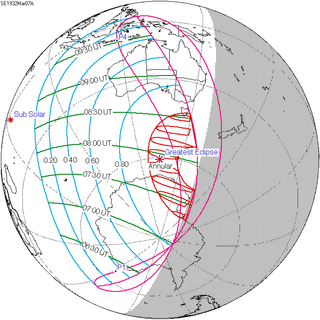| Solar eclipse of March 7, 1932 | |
|---|---|
| Type of eclipse | |
| Nature | Annular |
| Gamma | −0.9673 |
| Magnitude | 0.9277 |
| Maximum eclipse | |
| Duration | 319 s (5 min 19 s) |
| Coordinates | 60°42′S 134°24′E / 60.7°S 134.4°E |
| Max. width of band | 1,083 km (673 mi) |
| Times (UTC) | |
| Greatest eclipse | 7:55:50 |
| References | |
| Saros | 119 (61 of 71) |
| Catalog # (SE5000) | 9356 |
An annular solar eclipse occurred at the Moon's ascending node of orbit on Monday, March 7, 1932,[1] with a magnitude of 0.9277. A solar eclipse occurs when the Moon passes between Earth and the Sun, thereby totally or partly obscuring the image of the Sun for a viewer on Earth. An annular solar eclipse occurs when the Moon's apparent diameter is smaller than the Sun's, blocking most of the Sun's light and causing the Sun to look like an annulus (ring). An annular eclipse appears as a partial eclipse over a region of the Earth thousands of kilometres wide. Occurring about 3.6 days before apogee (on March 10, 1932, at 22:00 UTC), the Moon's apparent diameter was smaller.[2]
Annularity was visible from parts of Antarctica and southern Tasmania. A partial eclipse was visible for parts of Antarctica, Australia, and Southeast Asia.
- ^ "March 7, 1932 Annular Solar Eclipse". timeanddate. Retrieved 3 August 2024.
- ^ "Moon Distances for London, United Kingdom, England". timeanddate. Retrieved 3 August 2024.
